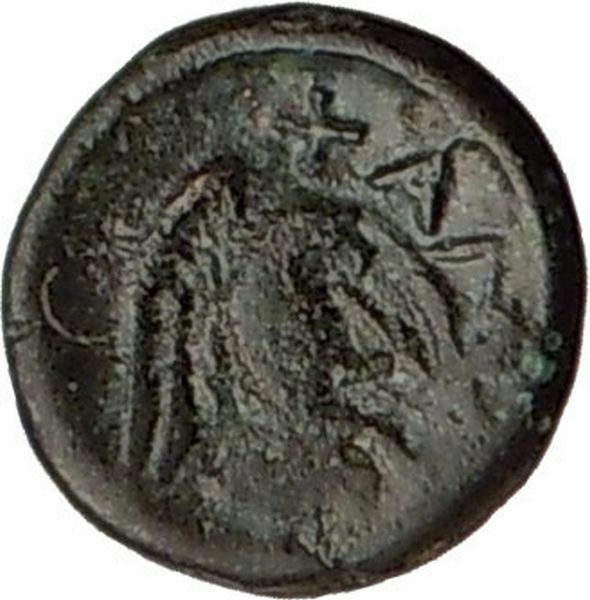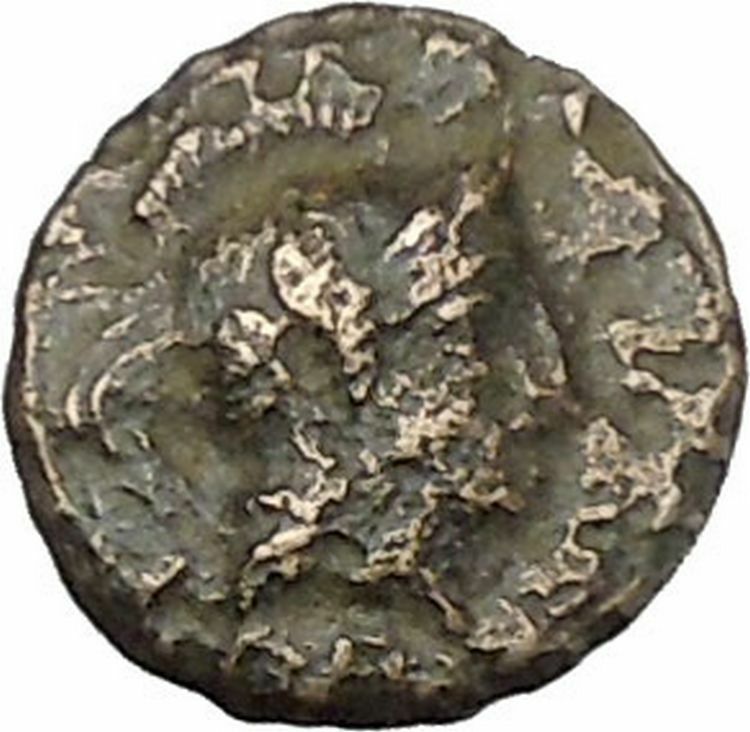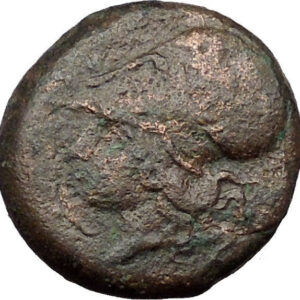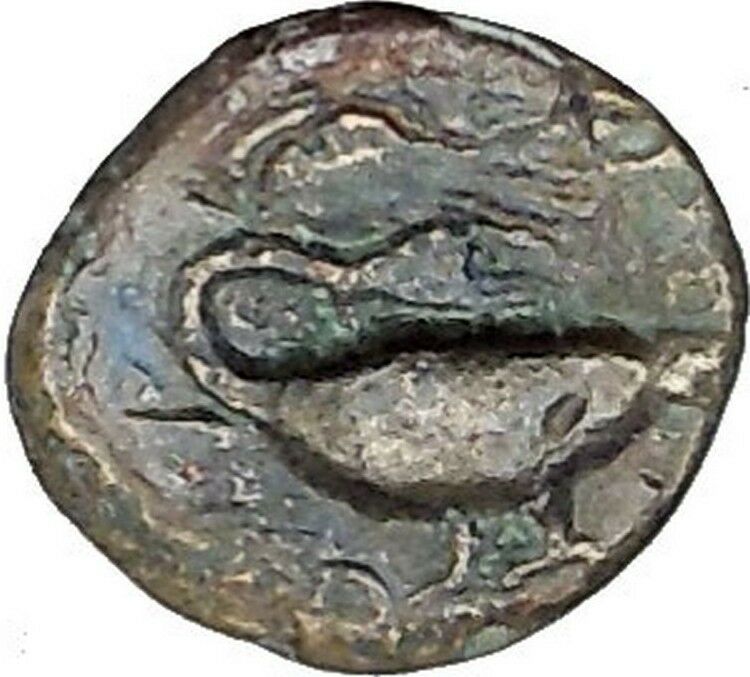|
Uncertain Greek city in
Pontus
Bronze 22mm (21.14 grams) Struck circa 130-100 B.C.
Reference: HGC 7, 310; SNG BM Black Sea 973; SNG Stancomb 649; SNG Copenhagen
232
Male head right, wearing strapal cap (bashlyk); Countermark: facing
gorgoneion in circular incuse.
Eight-rayed star; M in one of the compartments.
* Numismatic Note: This coin may actually be a portrait coin
of Mithradates VI, the Great. The reason for this belief is that HGC 7, 236 of
the city of Amisos in Pontus, describes this male head as being possibly of
Mithradates VI. Rare type.
You are bidding on the exact item pictured,
provided with a Certificate of Authenticity and Lifetime Guarantee of
Authenticity.
|
Mithridates VI |
King of
Kings |

Mithridates VI from the
Musée du Louvre
|
| Reign |
120–63 BC |
| Successor |
Pharnaces II of Pontus
|
| Father |
Mithridates V of Pontus
|
| Mother |
Laodice VI
|
Mithridates VI or Mithradates VI (Greek:
Μιθραδάτης),
from Old Persian Mithradatha, “gift of
Mithra
“; 134–63
BC, also known as Mithradates the Great (Megas) and Eupator
Dionysius, was king of
Pontus
and
Armenia Minor
in northern
Anatolia
(now Turkey
)
from about 120–63 BC. Mithridates is remembered as one of the
Roman Republic
’s most formidable and successful enemies, who engaged three
of the prominent generals from the late Roman Republic in the
Mithridatic Wars
:
Lucius Cornelius Sulla
,
Lucullus
and Pompey
. He
was also the greatest ruler of the Kingdom of Pontus.
Pontus is
a historical Greek designation for a region on the southern coast of the
Black Sea
, located in modern-day eastern
Black Sea Region
of
Turkey
. The name was applied to the coastal
region and its mountainous hinterland (rising to the
Pontic Alps
in the east) in
antiquity
by the
Greeks
who colonized the area and derived from
the Greek name of the Black Sea: Πόντος Εὔξεινος Pontos Euxeinos
(“Hospitable Sea”), or simply Pontos. Having originally no specific name,
the region east of the river
Halys
was spoken of as the country Ἐν Πόντῳ
En Pontōi, “on the [Euxeinos] Pontos”, and hence it acquired the name of
Pontus, which is first found in
Xenophon
‘s
Anabasis
. The extent of the region varied
through the ages but generally extended from the borders of
Colchis
(modern
Georgia
) until well into
Paphlagonia
in the west, with varying amounts
of hinterland
. Several states and provinces
bearing the name of Pontus or variants thereof were established in the region in
the Hellenistic,
Roman
and
Byzantine
periods, culminating in the late
Byzantine
Empire of Trebizond
. Pontus is sometimes
considered as the home of the
Amazons
, with the name Amazon used not only for
a city (Amasya)
but for all of Pontus in
Greek mythology
.

Map showing the Middle East in 89 BC, with the Kingdom of
Pontus, under Mithridates VI the Great, in green.
History
Pontus became important as a bastion of
Byzantine Greek
and
Greek Orthodox
civilization and attracted
Greeks from all backgrounds (scholars, traders, mercenaries, refugees) from all
over Anatolia
and the southern
Balkans
, from the
Classical
and
Hellenistic
periods into the
Byzantine
and
Ottoman
. These Greeks of Pontus are generally
referred to as
Pontic Greeks
.
Early inhabitants
Pontus remained outside the reach of the Bronze Age empires, of which the
closest was Great Hatti. The region went further uncontrolled by Hatti’s eastern
neighbours, Hurrian states like
Azzi and (or, or) Hayasa
. In those days,
the best any outsider could hope from this region was temporary alliance with a
local strongman. The Hittites called the unorganised groups on their
northeastern frontier the
Kaška
. As of 2004 little had been found of them
archaeologically.
In the wake of the Hittite empire’s collapse, the Assyrian court noted that
the “Kašku” had overrun its territory in conjunction with a hitherto unknown
group whom they labeled the
Muški
. Iron Age visitors to the region, mostly
Greek, noted that the hinterlands remained disunited, and they recorded the
names of tribes: Moskhians (often associated with those Muški),
Leucosyri
, Mares,
Makrones
,
Mossynoikians
,
Tibareni
, Tzans (Armenian: Chaniuk), and
Chaldians (Armenian: Khaghtik).
The
Armenian language
went unnoted by the Hittites,
the Assyrians, and all the post-Hittite nations; an ancient theory is that its
speakers migrated from Phrygia, past literary notice, across Pontus during the
early Iron Age.[10]
The Greeks
, who spoke a related Indo-European
tongue, followed them along the coast. The Greeks are the earliest long-term
inhabitants of the region from whom written records survive. During the late 8th
century BCE, Pontus further became a base for the
Cimmerians
; however, these were defeated by the
Lydians, and became a distant memory after the campaigns of
Alyattes II
.
Since there was so little literacy in northeastern Anatolia until the Persian
and Hellenistic era, one can only speculate as to the other languages spoken
here. Given that Kartvelian languages remain spoken to the east of Pontus, some
are suspected to have been spoken in eastern Pontus during the Iron Age: the
Tzans are usually associated with today’s Laz.
Ancient Greek
colonization
The first travels of Greek merchants and adventurers to the Pontus region
occurred probably from around 1000 BC, whereas their settlements would become
steady and solidified cities only by the 8th and 7th centuries BC as
archaeological findings document. This fits in well with a foundation date of
731 BC as reported by
Eusebius of Caesarea
for
Sinope
, perhaps the most ancient of the Greek
Colonies in what was later to be called Pontus.[12]
The epical narratives related to the travels of
Jason
and the
Argonauts
to
Colchis
, the tales of
Heracles
‘ navigating the Black Sea and
Odysseus
‘ wanderings into the land of the
Cimmerians
, as well as the myth of
Zeus constraining
Prometheus
to the
Caucasus
mountains as a punishment for his
outwitting the Gods, can all be seen as reflections of early contacts between
early Greek colonists and the local, probably Caucasian, peoples. The earliest
known written description of Pontus, however, is that of
Scylax of Korianda
, who in the 7th century BC
described Greek settlements in the area.
Persian Empire
expansion
By the 6th century BC, Pontus had become officially a part of the
Achaemenid Empire
, which probably meant that
the local Greek colonies were paying tribute to the Persians. When the Athenian
commander Xenophon
passed through Pontus around a century
later in 401-400 BC, in fact, he found no Persians in Pontus.
The peoples of this part of northern
Asia Minor
were incorporated into the third and
nineteenth
satrapies
of the Persian empire.
Iranian influence ran deep, illustrated most famously by the temple
of the Persian deities Anaitis, Omanes, and Anadatos at
Zela, founded by victorious Persian generals in the 6th century BCE.
The site flourished and became so important that it was here that the people of
Pontus made their most sacred vows. Even in
Strabo
‘s day it was still a dynamic center of
Persian culture and religion. Persian names, particularly Pharnakes, are found
scattered around the kingdom and are held most prominently by the ruling
Mithradatids, who are also the best evidence for Persian colonization of the
area. They were a powerful and noble Persian family, probably directly related
to
Darius the Great
himself, which in the 5th and
4th centuries BCE had held sway as dynasts over the regions of
Mysia
and Mariandynia on the
Propontis
and farther east along the south
shore of the Black Sea
. As the
Encyclopaedia Iranica
states, even when the
Mithradates known as “Founder” proclaimed himself king in the early years of the
3rd century BCE, and the family adopted some of the ways of Hellenism and
Hellenistic courts, in particular the use of Greek as the official language,
they continued proudly to proclaim their royal Achaemenid lineage: their search
for respectability and legitimization through Persian descent attests a deep and
powerful Persian ethos in the people of Pontus.
Pontus came out from Persian domination when the Kingdom of
Cappadocia
separated from the Achaemenid
Empire, taking Pontus with it as one of its provinces. Subsequently, Pontus
itself separated from the Kingdom of Cappadocia under
Mithridates I Ktistes
(“Ktistes”, Κτίστης
meaning “The Founder”, Constructor in Greek) in 302 BC and became independent.
As the greater part of the kingdom
he eventually established
lay within the
immense region of Cappadocia, which in early ages extended from the borders of
Cilicia
to the
Euxine
(Black Sea), the kingdom as a whole was
at first called “Cappadocia towards the Pontus”, but afterwards simply “Pontus”,
the name Cappadocia being henceforth restricted to the southern half of the
region previously included under that title.
Kingdom of Pontus
Main article:
Kingdom of Pontus
The
Kingdom of Pontus
extended generally to the
east of the Halys River. The
Persian
dynasty which was to found this kingdom
had during the 4th century BC ruled the Greek city of
Cius (or Kios) in
Mysia
, with its first known member being
Ariobarzanes I of Cius
and the last ruler based
in the city being
Mithridates II of Cius
. Mithridates II’s son,
also called Mithridates, would become Mithridates I Ktistes of Pontus.
As the
Encyclopaedia Iranica
states, the most
famous member of the family,
Mithradates VI Eupator
, although undoubtedly
presenting himself to the Greek world as a civilized philhellene and new
Alexander, also paraded his
Iranian
background: he maintained a harem and
eunuchs in true Oriental fashion; he gave all his sons Persian names; he
sacrificed spectacularly in the manner of the Persian kings at
Pasargadae
(Appian, Mith. 66, 70); and he
appointed “satraps”
(a Persian title) as his provincial governors. Iranica further states, and
although there is only one inscription attesting it, he seems to have adopted
the title “king of kings.” The very small number of Hellenistic Greek
inscriptions that have been found anywhere in Pontus suggest that
Greek culture
did not substantially penetrate
beyond the coastal cities and the court.
During the troubled period following the death of
Alexander the Great
, Mithridates Ktistes was
for a time in the service of
Antigonus
, one of Alexander’s
successors
, and successfully maneuvering in
this unsettled time managed, shortly after 302 BC, to create the Kingdom of
Pontus which would be ruled by his descendants mostly bearing the same name,
until 64 BC. Thus, this Persian dynasty managed to survive and prosper in the
Hellenistic
world while the main
Persian Empire
had fallen.
This kingdom reached its greatest height under
Mithridates VI
or Mithridates Eupator, commonly
called the Great, who for many years carried on war with the Romans. Under him,
the realm of Pontus included not only Pontic Cappadocia but also the seaboard
from the Bithynian
frontier to
Colchis
, part of inland
Paphlagonia
, and
Lesser Armenia
. Despite ruling Lesser Armenia,
King Mithridates VI was an ally of Armenian King
Tigranes the Great
, to whom he married his
daughter Cleopatra. Eventually, however, the Romans defeated both King
Mithridates VI and his son-in-law, Armenian King Tigranes the Great, during the
Mithridatic Wars
, bringing Pontus under Roman
rule.
Roman province
Main article:
Bithynia et Pontus
The Roman client kingdom of Pontus (in union with Colchis), c. 50 AD
With the subjection of this kingdom by
Pompey
in 64 BC, in which little changed in the
structuring of life, neither for the oligarchies that controlled the cities nor
for the common people in city or hinterland, the meaning of the name Pontus
underwent a change. Part of the kingdom was now annexed to the
Roman Empire
, being united with Bithynia in a
double province called Pontus and Bithynia: this part included only the
seaboard between
Heraclea
(today
Ereğli
) and
Amisus
(Samsun),
the ora Pontica. The larger part of Pontus, however, was included in the
province of Galatia.
Hereafter the simple name Pontus without qualification was regularly employed
to denote the half of this dual province, especially by Romans and people
speaking from the Roman point of view; it is so used almost always in the
New Testament
. The eastern half of the old
kingdom was administered as a
client kingdom
together with
Colchis
. Its last king was
Polemon II
.
In AD 62, the country was constituted by
Nero a
Roman province
. It was divided into the three
districts: Pontus Galaticus in the west, bordering on
Galatia
; Pontus Polemoniacus in the
centre, so called from its capital
Polemonium
; and Pontus Cappadocicus in
the east, bordering on Cappadocia (Armenia Minor). Subsequently, the Roman
Emperor Trajan
moved Pontus into the province of
Cappadocia itself in the early 2nd century AD. In response to a
Gothic
raid on Trebizond in 457 AD, the Roman
Emperor Diocletian
decided to break up the area into
smaller provinces under more localized administration.
The
Diocese of Pontus
and its provinces
in c. AD 400
With the reorganization of the provincial system under Diocletian (about AD
295), the Pontic districts were divided up between three smaller, independent
provinces within the
Dioecesis Pontica
:
- Galatian Pontus, also called Diospontus, later renamed
Helenopontus by
Constantine the Great
after his
mother
. It had its capital at
Amisus
, and included the cities of
Sinope
,
Amasia
,
Andres
,
Ibora
, and
Zela
as well.
- Pontus Polemoniacus, with its capital at Polemonium (also called
Side
), and including the cities of
Neocaesarea
,
Argyroupolis
, Comana, and Cerasus as well.
- Cappadocian Pontus, with its capital at Trebizond, and including
the small ports of
Athanae
and
Rhizaeon
. This province extended all the
way to Colchis.
Byzantine
province and theme
The Byzantine Emperor
Justinian
further reorganized the area in 536:
- Pontus Polemoniacus was dissolved, with the western part (Polemonium
and Neocaesarea) going to Helenopontus, Comana going to the new province of
Armenia II
, and the rest (Trebizond and
Cerasus) joining the new province of
Armenia I Magna
with its capital at
Justinianopolis.
- Helenopontus gained Polemonium and Neocaesarea, and lost Zela to
Armenia II. The provincial governor was relegated to the rank of
moderator.
- Paphlagonia absorbed Honorias and was put under a
praetor
.
By the time of the early Byzantine Empire, Trebizond became a center of
culture and scientific learning. In the 7th century, an individual named
Tychicus returned from Constantinople to establish a school of learning. One of
his students was the early Armenian scholar
Anania of Shirak
.
Under the Byzantine Empire, the Pontus came under the
Armeniac Theme
, with the westernmost parts (Paphlagonia)
belonging to the
Bucellarian Theme
. Progressively, these large
early themes were divided into smaller ones, so that by the late 10th century,
the Pontus was divided into the themes of
Chaldia
, which was governed by the Gabrades
family, and Koloneia. After the 8th century, the area experienced a period of
prosperity, which was brought to an end only by the
Seljuk
conquest of Asia Minor in the 1070s and
1080s. Restored to the Byzantine Empire by
Alexios I Komnenos
, the area was governed by
effectively semi-autonomous rulers, like the Gabras family of Trebizond.
Empire of Trebizond
Following
Constantinople’s loss of sovereignty
to the
Fourth Crusade
in 1204, the Pontus retained
independence as the
Empire of Trebizond
under the
Komnenos
dynasty. Through a combination of
geographic remoteness and adroit diplomacy, this remnant managed to survive,
until it was conquered by the
Ottomans
in 1461 after the
Fall of Constantinople
itself. This political
adroitness included becoming a vassal state at various times to both Georgia and
to various inland Turkic rulers. In addition, the Empire of Trebizond became a
renowned center of culture under its ruling Komnenos dynasty.
|












